Coming to a neighborhood near you: Housing for lesbian, gay, bisexual. transgender and queer (LGBTQ) elders.
The issue is a fast-moving train that has left the station, with True Blue Believers in other major cities already onboard.
Plus, The Washington Post says the national model is in Philadelphia.
And pro-LGBTQ folks in D.C., St. Louis and New York likely won’t be far behind. In fact, New York is helping to set the scene Tuesday as host to activists and policymakers of a national strategy discussion. Senior Obama adviser Jennifer Ho of the U.S. Department of Housing and Urban Development is scheduled to participate, as my colleague David Sherfinski reported Monday morning.
Here, in part, is how the LGBTQ issue became a top priority in the gender-identity community during Barack Obama’s second term.
• In 2013, a federal housing study found that when heterosexual married couples look for a place to live, they are slightly more likely to get a favorable response than gay couples. HUD said that while the gap isn’t huge, it did find more discrimination in states that had laws on anti-gay discrimination than those that didn’t. The five-month national study covered 50 metropolitan markets and took place in 2011.
The study shows “we need to continue our efforts to ensure that everyone is treated the same when it comes to finding a home to call their own, regardless of their sexual orientation,” HUD Secretary Shaun Donovan said.
• The federal study led to an interesting human interest piece reported out of Philadelphia by The Associated Press.
It highlights the euphoria of aging members of the LGBTQ community who now have their own housing community in the heart of Philadelphia, the City of Brotherly Love. It says Jerry Zeft, at that time 70 years old, was so elated he slept on an air mattress until his bed arrived a week or so later.
Minneapolis and Los Angeles have similar LGBTQ housing projects up and running, two more complexes are under construction in Chicago and San Francisco, and the “[Dr. Magnus] Hirschfeld Fund is interested in building units in New York,” AP reported.
“At the 56-unit Philadelphia building, monthly rents range from $192 to $786 based on income, which can’t exceed $33,000 per year,” AP reported. “There is a waiting list for lower-tier units, though about a dozen remain at the upper end. Nearly all the residents identify as LGBT.”
Does this sector of the affordable housing debate jibe with reality?
You be the judge.
• “Less than 3 percent of the adult U.S. population is a sexual minority, the federal government says in a new report that asks people about their sexual orientation and health,” another colleague, Cheryl Wetzstein, reported shortly before Christmas. “About 97 percent of the adult U.S. population, or 224 million people, described themselves as ’straight’ or heterosexual, the National Center for Health Statistics said in a new study on sexual orientation data in the National Health Interview Survey (NHIS).
“Another 5.6 million adults said they were gay or lesbian (1.6 percent), bisexual (0.7 percent) or ’something else’ (0.2 percent),” Cheryl’s story said. “Another group, representing about 1 million adults, refused to answer sexual-orientation questions, while another 879,000 said they didn’t ’know’ the answers to the questions.”
Some respondents said they were “queer, trisexual, omnisexual or pansexual,” and “transgender, transsexual or gender variant.”
In other words, the small LGBTQ community can be as racially, ethnically and culturally diverse as the entire daggum globe.
What’s next? Pigeonholing heterosexuals in housing projects?
Cheryl reported that nearly 34,000 adults were interviewed in the NHIS study, and 155 of them said they didn’t “know” their sexual orientation.
Something’s amiss when adults are asked in a federal study to identify their sexual orientation and these adults respond by saying they are clueless.
President Obama proposed in his budget, released Monday, that HUD’s Housing Opportunities for Persons with AIDS, which provides housing for low-income people with AIDS, $332 million, include an increase of a couple of million dollars. Also, LGBTQ advocates say the formula for distributing those funds will change to serve areas most in need.
Now you know why I said coming to “a neighborhood near you.”
• Deborah Simmons can be reached at dsimmons@washingtontimes.com.
• Deborah Simmons can be reached at dsimmons@washingtontimes.com.




Please read our comment policy before commenting.